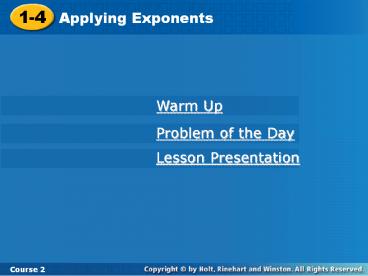Warm Up - PowerPoint PPT Presentation
1 / 21
Title:
Warm Up
Description:
1-4 Applying Exponents Warm Up Problem of the Day Lesson Presentation Course 2 Warm Up Find each value. 1. 92 3. 152 5. 103 81 144 225 2. 122 4. 102 100 6. 104 1,000 ... – PowerPoint PPT presentation
Number of Views:68
Avg rating:3.0/5.0
Title: Warm Up
1
Warm Up
Problem of the Day
Lesson Presentation
2
Warm Up Find each value. 1. 92 3. 152 5. 103
81
2. 122
144
225
4. 102
100
1,000
10,000
6. 104
3
Problem of the Day Each day, Lowell runs one
more lap than he did the day before. After seven
days he has run a total of 77 laps. How many laps
did he run on the first day?
8
4
Learn to express large numbers in scientific
notation.
5
Vocabulary
scientific notation
6
The distance from Venus to the Sun is over
100,000,000 kilometers. You can write this number
as a power of ten by using a base of ten and an
exponent.
10 10 10 10 10 10 10 10 108
Power of ten
7
The table shows several powers of ten.
Power of 10
Meaning
Value
101
10
10
102
10 10
100
10 10 10
1,000
103
10 10 10 10
104
10,000
8
Additional Example 1A Multiplying by Powers of
Ten
Multiply 14 103.
Method 1 Evaluate the power.
Multiply 10 by itself 3 times.
14 103 14 (10 10 10)
14 1,000
Multiply.
14,000
9
Additional Example 1B Multiplying by Powers of
Ten
Multiply 14 103.
Method 2 Use mental math.
Move the decimal point 3 places. (You will need
to add 3 zeros.)
14 103 14.000
3 places
14,000
10
Check It Out Example 1A
Multiply 12 102.
Method 1 Evaluate the power.
Multiply 10 by itself 2 times.
12 102 12 (10 10)
Multiply.
12 100
1,200
11
Check It Out Example 1B
Multiply 12 102.
Method 2 Use mental math.
Move the decimal point 2 places. (You will need
to add 2 zeros.)
12 102 12.00
2 places
1,200
12
Scientific notation is a kind of shorthand that
can be used to write large numbers. Numbers
expressed in scientific notation are written as
the product of two factors. In scientific
notation, 17,900,000 is written as
7
x 10
1.79
A power of 10
A number greater than or equal to 1 but less than
10
13
Writing Math
In scientific notation, it is customary to use a
multiplication cross (?) instead of a dot.
14
Additional Example 2 Writing Numbers in
Scientific Notation
Write the number 4,340,000 in scientific notation.
Move the decimal point to get a number that is
greater than or equal to 1 and less than 10.
4,340,000 4,340,000
The exponent is equal to the number of places
the decimal point is moved.
4.34 ? 106
15
Check It Out Example 2
Write the number 8,421,000 in scientific notation.
Move the decimal point to get a number that is
greater than or equal to 1 and less than 10.
8,421,000 8,421,000
The exponent is equal to the number of places
the decimal point is moved.
8.421 ? 106
16
Additional Example 3 Writing Numbers in Standard
Form
The population of China in the year 2000 was
estimated to be about 1.262 ? 109. Write this
number in standard form.
Since the exponent is 9, move the decimal point 9
places to the right.
1.262 ? 109 1.262000000
1,262,000,000
The population of China was about
1,262,000,000 people.
17
Check It Out Example 3
The distance from the Earth to the Sun is
calculated to be 1.5 ? 108 kilometers. Write this
distance in standard form.
Since the exponent is 8, move the decimal point 8
places to the right.
1.5 ? 108 1.50000000
150,000,000
The distance from the Earth to the Sun is about
150,000,000 kilometers.
18
Additional Example 4 Comparing Numbers in
Scientific Notation
In 2005, the population of Mexico was 1.06 ? 108
and the population of Brazil was 1.86 ? 108. In
which country do more people live?
To compare numbers written in scientific
notation, first compare the exponents. If the
exponents are equal, then compare the decimal
portion of the numbers.
Brazil has more people living there.
19
Check It Out Additional Example 4
The number of coins in Tys jar was 0.76 ? 104
and number of coins in Laurels jar was 0.93 ?
103. In which jar are there more coins?
To compare numbers written in scientific
notation, first compare the exponents. If the
exponents are equal, then compare the decimal
portion of the numbers.
Tys jar has more coins in it.
20
Lesson Quiz Part I
Multiply.
2,500
1. 25 ? 102
2. 18 ? 104
180,000
3. 110 ? 102
11,000
4. 3.742 ? 103
3,742
21
Lesson Quiz Part II
Write each number in scientific notation. 5.
7,400,000 6. 45,000 7. Earth is about 9.292 ?
107 miles from the Sun. Write this number in
standard form.
7.4 ? 106
4.5 ? 104
92,920,000































